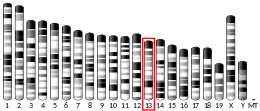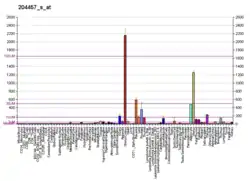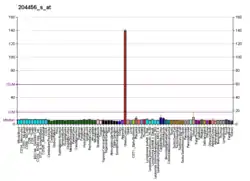Growth arrest-specific protein 1 is a protein that in humans is encoded by the GAS1 gene.[5][6]
Function
Growth arrest-specific 1 plays a role in growth suppression. GAS1 blocks entry to S phase and prevents cycling of normal and transformed cells. Gas1 is a putative tumor suppressor gene.[6]
Discovery
The mouse cells, which appear the growth-arrested, were observed expression of Growth Arrest Specific-1 gene (GAS1).[5] In 1988, Gas-1 was first defined as one of six genes that block transcriptional up-regulation of the NIH3T3 cell cycle from G0 to S phase.[6] Most of scientist have proved that overexpressed gas1 has the function of inhibiting tumor growth and progression in gliomas. Furthermore, GAS1 gene was also thought to contribute to recurrence and metastasized prediction in colon cancer.
Gene location of GAS1
GAS-1 gene has been identified as a putative tumor suppressor collocates on chromosome 9q21.3-22.1 where was considered to be a fragile site.[7] In 1994, 29 metaphases were analyzed by Del Sal et al, and 102 fluorescent signals were observed during the experiment. The results showed that 84 (82%) expression rate of the fluorescent signal on chromosome 9.[8] Furthermore, the peak signal density of the fluorescent also observed occurring in the q21.3-22.1 region.[8] In addition, the inexpression of the fluorescent signal cluster on any other chromosome further demonstrates Gas1 gene specifically expresses on chromosome 9q21.3-22.1.[8]
GAS1 characteristic
345 amino acids were confirmed to constitute mature Gas-1 gene. Asn117 and an aminated Ser318 are two particular position which result in discovering of the one N-glycosylation site and potential signal peptide, respectively.[9]
Gene structure
Gas-1 gene has been confirmed to be highly similar to the GFRα1 gene (28% similarity) while the Gas1 only consists of two domains which is different from the GFRα1-3 that composes of three domains.[10][11] Although the structure of GAS1 gene is similar to GFRαs, the function of GAS1 is largely different from GFRαs since the GAS 1 gene has the ability of binding RET in a ligand independent manner.[11][12] Since the structure similarity between GAS1 and GFRαs, the ancestor of GFRα proteins was suspected to be the GAS1.[12] In regard to the secondary structure, most of mammalian Gas1 gene’s secondary structure were identified to be mostly α-helical and to have a long unstructured C-terminal domain[10]
Gene expression
GAS1 protein widespread distributed in adult mammalian CNS ( central nervous system). Adult mouse brain has been described expressing GAS1 mRNA, and the experiment of Natanael Zarco et al further corroborated this description.[13] Western blot analysis is the main method which has been used in their practical and plays an significant role in successfully determining the distribution of the protein in the adult central nervous system (CNS).[13] Olfactory bulb, caudate-putamen, cerebral cortex, hippocampus, mesencephalon, medulla oblongata, cerebellum, and cervical spinal cord has been identified as the specific expression parts of GAS1.[13] Despite the pattern of expression in Astrocyte cells was more limited than in neurons, the gas1 was also found expressing in that part.
Function
GAS1 was identified as a pleiotropic protein with the function of cell arrest and apoptosis. GAS1 can induce intrinsic apoptosis; this pathway does not involve the activity of caspase 8.[14] GAS1 accomplishes this by inhibiting GDNF-induced phosphorylation of RET, which leads to decreased phosphorylation of AKT; this decrease facilitates the dephosphorylation of BAD, which triggers the release of cytochrome c from the mitochondria and subsequent formation of the apoptosome, ultimately resulting in apoptosis.[14]
Except that, the nervous system and other amount of organs can also be largely influenced by the abnormal Gas1 gene. The reason of this dual function is likely caused by its ability of interacting with the inhibited signaling cascade which induced by GNDF (glial cell-line derived neurotrophic factor).[13] Additionally, GAS1 has been proved can largely influence the developmental state of the organs.[15] During the development stage of the GAS1, it has been suggested that development GAS1 can not only inhibit cell proliferation but also control the cell death as well as growth of the cerebellum.[9] The signal emission of GAS 1 protein associate with two different types of transmembrane receptor protein, including RET and the Hedgehog receptor protein,[16] GAS1 is therefore determined as a kind of multifunctional protein. The Hedgehog signaling pathway is known as an essential part in the body which largely influences the body development, and cancer progression since the Sonic hedgehog can be connected by GAS1 directly, and lead to active of the signaling pathway.[17]
Associated diseases
Kidney hypoplasia
The GAS1 gene plays a significant role in kidney development. Conserved DNA binding motif, which is located in the Gas1 promoter, is directly bind by the WT1, and then the Gas1 mRNA is activated to transcript to the NPCs.[18] The WT1 has been confirmed as a necessary part for expressing Gas1 in kidneys in vivo. Loss of function of GAS1 in vivo results in hypoplastic kidneys with reduced nephron mass due to premature depletion of NPCs.[18] In humans, fetal period is the most significant time point for inducting a new nephrons, no matter what kind of mammals, once the NPCS disappeared, there is no possibility for inducing the new nephrons.[18]
Gene mutation
Gas1 gene has been mapped by the method of in situ hybridization to human chromosome bands 9q21.3-q22,[8] a fragile site where frequently deleted in human tumors, especially acute myeloid leukemia and bladder tumors.[19] The deletion region of early superficial bladder cancer indicated that the frequent (50%) deletion of tumor suppressor genes was located between 9q22 and 9p12-13, an area that spanned the GAS1 gene position and could be a starting event for bladder cancer disease.[20] However, a study that has been done by Simoneau et al indicates that there is no mutations in the gas1 gene in 14 primary bladder carcinomas and 10 bladder carcinoma cell lines, which means the mutation of gas1 is not the main reason in causing the pathogenesis.
References
- 1 2 3 GRCh38: Ensembl release 89: ENSG00000180447 - Ensembl, May 2017
- 1 2 3 GRCm38: Ensembl release 89: ENSMUSG00000052957 - Ensembl, May 2017
- ↑ "Human PubMed Reference:". National Center for Biotechnology Information, U.S. National Library of Medicine.
- ↑ "Mouse PubMed Reference:". National Center for Biotechnology Information, U.S. National Library of Medicine.
- 1 2 Evdokiou A, Webb GC, Peters GB, Dobrovic A, O'Keefe DS, Forbes IJ, Cowled PA (December 1993). "Localization of the human growth arrest-specific gene (GAS1) to chromosome bands 9q21.3-q22, a region frequently deleted in myeloid malignancies". Genomics. 18 (3): 731–733. doi:10.1016/S0888-7543(05)80388-X. PMID 8307588.
- 1 2 3 "Entrez Gene: GAS1 growth arrest-specific 1".
- ↑ Blair IP, Dawkins JL, Nicholson GA (1997). "Fine mapping of the hereditary sensory neuropathy type I locus on chromosome 9q22.1-->q22.3: exclusion of GAS1 and XPA". Cytogenetics and Cell Genetics. 78 (2): 140–144. doi:10.1159/000134649. PMID 9371409.
- 1 2 3 4 Del Sal G, Collavin L, Ruaro ME, Edomi P, Saccone S, Valle GD, Schneider C (March 1994). "Structure, function, and chromosome mapping of the growth-suppressing human homologue of the murine gas1 gene". Proceedings of the National Academy of Sciences of the United States of America. 91 (5): 1848–1852. Bibcode:1994PNAS...91.1848D. doi:10.1073/pnas.91.5.1848. PMC 43261. PMID 8127893.
- 1 2 Stebel M, Vatta P, Ruaro ME, Del Sal G, Parton RG, Schneider C (September 2000). "The growth suppressing gas1 product is a GPI-linked protein". FEBS Letters. 481 (2): 152–158. doi:10.1016/s0014-5793(00)02004-4. PMID 10996315. S2CID 33219546.
- 1 2 Schueler-Furman O, Glick E, Segovia J, Linial M (February 2006). "Is GAS1 a co-receptor for the GDNF family of ligands?". Trends in Pharmacological Sciences. 27 (2): 72–77. doi:10.1016/j.tips.2005.12.004. PMID 16406089.
- 1 2 Cabrera JR, Sanchez-Pulido L, Rojas AM, Valencia A, Mañes S, Naranjo JR, Mellström B (May 2006). "Gas1 is related to the glial cell-derived neurotrophic factor family receptors alpha and regulates Ret signaling". The Journal of Biological Chemistry. 281 (20): 14330–14339. doi:10.1074/jbc.M509572200. hdl:10261/153703. PMID 16551639.
- 1 2 Airaksinen MS, Holm L, Hätinen T (2006). "Evolution of the GDNF family ligands and receptors". Brain, Behavior and Evolution. 68 (3): 181–190. doi:10.1159/000094087. PMID 16912471. S2CID 44430118.
- 1 2 3 4 Zarco N, Bautista E, Cuéllar M, Vergara P, Flores-Rodriguez P, Aguilar-Roblero R, Segovia J (October 2013). "Growth arrest specific 1 (GAS1) is abundantly expressed in the adult mouse central nervous system". The Journal of Histochemistry and Cytochemistry. 61 (10): 731–748. doi:10.1369/0022155413498088. PMC 3788624. PMID 23813868.
- 1 2 Zarco N, González-Ramírez R, González RO, Segovia J (June 2012). "GAS1 induces cell death through an intrinsic apoptotic pathway". Apoptosis. 17 (6): 627–635. doi:10.1007/s10495-011-0696-8. PMID 22311470. S2CID 254250592.
- ↑ Lee CS, Fan CM (March 2001). "Embryonic expression patterns of the mouse and chick Gas1 genes". Mechanisms of Development. 101 (1–2): 293–297. doi:10.1016/s0925-4773(01)00283-0. PMID 11231094. S2CID 828060.
- ↑ Allen BL, Tenzen T, McMahon AP (May 2007). "The Hedgehog-binding proteins Gas1 and Cdo cooperate to positively regulate Shh signaling during mouse development". Genes & Development. 21 (10): 1244–1257. doi:10.1101/gad.1543607. PMC 1865495. PMID 17504941.
- ↑ Martinelli DC, Fan CM (November 2007). "The role of Gas1 in embryonic development and its implications for human disease". Cell Cycle. 6 (21): 2650–2655. doi:10.4161/cc.6.21.4877. PMID 17726382.
- 1 2 3 Kann M, Bae E, Lenz MO, Li L, Trannguyen B, Schumacher VA, et al. (April 2015). "WT1 targets Gas1 to maintain nephron progenitor cells by modulating FGF signals". Development. 142 (7): 1254–1266. doi:10.1242/dev.119735. PMC 4378252. PMID 25804736.
- ↑ Sreekantaiah C, Baer MR, Preisler HD, Sandberg AA (May 1989). "Involvement of bands 9q21-q22 in five cases of acute nonlymphocytic leukemia". Cancer Genetics and Cytogenetics. 39 (1): 55–64. doi:10.1016/0165-4608(89)90229-x. PMID 2731148.
- ↑ Cairns P, Shaw ME, Knowles MA (April 1993). "Initiation of bladder cancer may involve deletion of a tumour-suppressor gene on chromosome 9". Oncogene. 8 (4): 1083–1085. PMID 8096074.
Further reading
- Del Sal G, Ruaro ME, Philipson L, Schneider C (August 1992). "The growth arrest-specific gene, gas1, is involved in growth suppression". Cell. 70 (4): 595–607. doi:10.1016/0092-8674(92)90429-G. PMID 1505026. S2CID 21883176.
- Wicking C, Breen M, Negus K, Berkman J, Evdokiou A, Cowled P, et al. (1994). "The human growth-arrest-specific gene GAS1 maps outside the candidate region of the gene for nevoid basal cell carcinoma syndrome". Cytogenetics and Cell Genetics. 68 (1–2): 119–121. doi:10.1159/000133904. PMID 7956349.
- Del Sal G, Collavin L, Ruaro ME, Edomi P, Saccone S, Valle GD, Schneider C (March 1994). "Structure, function, and chromosome mapping of the growth-suppressing human homologue of the murine gas1 gene". Proceedings of the National Academy of Sciences of the United States of America. 91 (5): 1848–1852. Bibcode:1994PNAS...91.1848D. doi:10.1073/pnas.91.5.1848. PMC 43261. PMID 8127893.
- Evdokiou A, Cowled PA (February 1998). "Tumor-suppressive activity of the growth arrest-specific gene GAS1 in human tumor cell lines". International Journal of Cancer. 75 (4): 568–577. doi:10.1002/(SICI)1097-0215(19980209)75:4<568::AID-IJC13>3.0.CO;2-5. PMID 9466658.
- Stebel M, Vatta P, Ruaro ME, Del Sal G, Parton RG, Schneider C (September 2000). "The growth suppressing gas1 product is a GPI-linked protein". FEBS Letters. 481 (2): 152–158. doi:10.1016/S0014-5793(00)02004-4. PMID 10996315. S2CID 33219546.
- Lee CS, Buttitta L, Fan CM (September 2001). "Evidence that the WNT-inducible growth arrest-specific gene 1 encodes an antagonist of sonic hedgehog signaling in the somite". Proceedings of the National Academy of Sciences of the United States of America. 98 (20): 11347–11352. Bibcode:2001PNAS...9811347L. doi:10.1073/pnas.201418298. PMC 58732. PMID 11572986.
- Baladrón V, Ruiz-Hidalgo MJ, Bonvini E, Gubina E, Notario V, Laborda J (February 2002). "The EGF-like homeotic protein dlk affects cell growth and interacts with growth-modulating molecules in the yeast two-hybrid system". Biochemical and Biophysical Research Communications. 291 (2): 193–204. doi:10.1006/bbrc.2002.6431. PMID 11846389.
- Mellström B, Ceña V, Lamas M, Perales C, Gonzalez C, Naranjo JR (March 2002). "Gas1 is induced during and participates in excitotoxic neuronal death". Molecular and Cellular Neurosciences. 19 (3): 417–429. doi:10.1006/mcne.2001.1092. PMID 11906213. S2CID 31105269.
- Strausberg RL, Feingold EA, Grouse LH, Derge JG, Klausner RD, Collins FS, et al. (December 2002). "Generation and initial analysis of more than 15,000 full-length human and mouse cDNA sequences". Proceedings of the National Academy of Sciences of the United States of America. 99 (26): 16899–16903. Bibcode:2002PNAS...9916899M. doi:10.1073/pnas.242603899. PMC 139241. PMID 12477932.
- Xu Y, Kulkosky J, Acheampong E, Nunnari G, Sullivan J, Pomerantz RJ (May 2004). "HIV-1-mediated apoptosis of neuronal cells: Proximal molecular mechanisms of HIV-1-induced encephalopathy". Proceedings of the National Academy of Sciences of the United States of America. 101 (18): 7070–7075. Bibcode:2004PNAS..101.7070X. doi:10.1073/pnas.0304859101. PMC 406467. PMID 15103018.
- Cabrera JR, Sanchez-Pulido L, Rojas AM, Valencia A, Mañes S, Naranjo JR, Mellström B (May 2006). "Gas1 is related to the glial cell-derived neurotrophic factor family receptors alpha and regulates Ret signaling". The Journal of Biological Chemistry. 281 (20): 14330–14339. doi:10.1074/jbc.M509572200. hdl:10261/153703. PMID 16551639.





